Rhinoplasty is derived from the ancient Greek terms ‘rhinos‘ (nose) and ‘plassein‘ (to mould) and mainly serves two main purposes.
Rhinoplasty is an operation to change the shape of the nose and aims to make it breathe better and look more beautiful. This surgery is performed to solve problems with the nose, including accidental damage, congenital problems, difficulty breathing or problems caused by a previous surgery.
What is a Rhinoplasty Surgery?
Rhinoplasty surgery, commonly known as a nose job is a commonly used term for the surgical procedure that corrects and improves the shape, size, general appearance, and function of your nose.
The nasal septum is a thin wall that separates the inside of the nose into two separate nasal cavity. It usually consists of bone and cartilage. It is a procedure that can improve your breathing if your nose has airway obstruction due to a deviated nasal septum or collapse of the cartilage of your nose.
Nose surgery can be performed for cosmetic or reconstructive reasons. Cosmetic rhinoplasty nose surgery is done strictly to make your nose look better, and reconstructive rhinoplasty surgery is done to improve the function and breathing of your nose.
Are you not happy with the shape of your nose? Parts of the nose seem out of proportion to the rest of your face? Don’t you like the position of the nostril? These concerns are cosmetic or appearance-related. As such they are usually not covered by most insurance plans.
Cosmetic surgery is elective, the surgery that is designed to enhance the way you look, not to correct a condition that is affecting your health.
If your nasal problem is great enough it may be a good idea to have the surgery but not if you have significant other medical problems. Cosmetic concerns, abnormalities, and appearance are real problems. They are often dismissed as shallow or narcissistic, making individuals unhappy. Why live with something you do not like if you can have it changed?
Many patients who elect for a cosmetic change in appearance tell us later that they wonder why they waited so long and did not have the surgery sooner.
Watch this video of a patient’s journey undergoing a rhinoplasty
Types of Nose Surgery
There are two main types of rhinoplasty:
- Cosmetic Surgery: This type of rhinoplasty is typically performed for aesthetic purposes. It focuses on improving the appearance of the nose by altering its size, shape, or proportionality. Cosmetic rhinoplasty can address concerns such as a prominent hump, wide nostrils, a droopy or bulbous tip, or asymmetry.
- Functional Surgery: Functional rhinoplasty is primarily performed to address structural issues that affect the functionality of the nose. It aims to improve breathing difficulties caused by a deviated septum, nasal obstruction, or other anatomical abnormalities. Functional rhinoplasty can enhance airflow and alleviate symptoms such as snoring, sleep apnea, or chronic congestion.
Surgery Techniques and Procedures
There are several techniques and procedures involved in nose job. The most common techniques include open and closed rhinoplasty. The choice of technique depends on the patient’s individual needs and goals.
Open Rhinoplasty
Open rhinoplasty involves making an incision on the columella, which is the strip of skin that separates the nostrils. This technique provides the surgeon with better visibility and access to the underlying bone and cartilage structures. It is often used for more complex cases that require extensive reshaping of the nose.
During the procedure, the surgeon may remove bone or cartilage, or add grafts to reshape the nose. They may also use sutures to reshape the nostrils or adjust the angle between the nose and upper lip. Open rhinoplasty typically results in more swelling and longer recovery time compared to closed rhinoplasty.
Closed Rhinoplasty
Closed rhinoplasty involves making incisions inside the nostrils, which leaves no visible scarring. This technique is often used for less complex cases that require minor reshaping of the nose. It is also associated with less swelling and shorter recovery time compared to open rhinoplasty.
During the procedure, the surgeon may make incisions to access the bone and cartilage structures. They may remove or reshape bone and cartilage, or add grafts to achieve the desired shape. Closed rhinoplasty is a less invasive technique, but it may not be suitable for all patients.
Bone and Cartilage Grafting
In some cases, the surgeon may use bone or cartilage grafts to reshape the nose. These grafts can be taken from the patient’s own body, such as the rib or ear, or from a donor source. Bone and cartilage grafts are often used to build up the nasal bridge or tip, or to support the nasal structure.
The use of bone and cartilage grafts can increase the complexity of the procedure and prolong the recovery time. However, it can also provide more natural-looking and long-lasting results.
Nostril Reshaping
Nostril reshaping is a common component of nose surgery. The surgeon may use sutures to adjust the size, shape, or position of the nostrils. This can help to balance the overall appearance of the nose and create a more harmonious facial profile.
In some cases, the surgeon may also adjust the angle between the nose and upper lip. This can help to improve the appearance of a droopy or downturned nose.
Overall, nose surgery is a complex and highly individualized procedure. The choice of technique and procedure depends on the patient’s unique needs and goals. A skilled and experienced surgeon can help to guide the patient through the process and achieve the desired results.
Benefits
The benefits of rhinoplasty can be both physical and psychological. Here are some key advantages:
- Improved Facial Harmony: Rhinoplasty can enhance the overall balance and symmetry of your facial features, creating a more harmonious appearance.
- Boost in Self-Confidence: Many individuals who undergo rhinoplasty report feeling more confident and satisfied with their appearance. By addressing physical concerns, rhinoplasty can positively impact an individual’s self-esteem.
- Correction of Breathing Problems: Functional rhinoplasty can improve nasal airflow, alleviate breathing difficulties, and enhance overall respiratory function.
- Correcting Traumatic Injuries: Rhinoplasty can address nasal deformities caused by accidents or injuries, restoring the nose to its pre-injury condition.
Preparing
Before undergoing rhinoplasty, it is crucial to prepare yourself physically and mentally.
Here are some steps to follow:
- Consultation: Schedule a consultation with a qualified and experienced plastic surgeon. Discuss your expectations, concerns, and medical history. The surgeon will evaluate your suitability for the procedure and provide personalized recommendations.
- Medical Evaluation: Your surgeon may request a medical evaluation, including blood tests, to ensure you are in good health for surgery. They may also assess your nasal structure and breathing function.
- Quit Smoking: If you are a smoker, it is advisable to quit smoking before rhinoplasty, as smoking can hinder the healing process and increase the risk of complications.
- Medication Management: Inform your surgeon about any medications, supplements, or herbal remedies you are currently taking. They may ask you to discontinue certain medications that can interfere with the surgery or the healing process.
- Arrange Transportation and Postoperative Care: Plan for someone to drive you home after the surgery, and ensure you have someone available to assist you during the initial recovery phase.
Nose Job Procedures
The rhinoplasty procedure typically consists of the following steps:
- Anesthesia: Before the procedure begins, you will be administered either local anesthesia with sedation or general anesthesia to ensure your comfort during the surgery.
- Incisions: Depending on the complexity of the procedure, your surgeon may make incisions either inside the nostrils (closed rhinoplasty) or on the columella, the vertical strip of tissue between the nostrils (open rhinoplasty).
- Reshaping and Reconstruction: Your surgeon will then reshape the cartilage, bone, and tissue in your nose to achieve the desired result. This may involve removing or rearranging tissue, grafting cartilage, or adding synthetic implants.
- Closing the Incisions: Once the necessary modifications have been made, the incisions will be carefully closed using sutures.
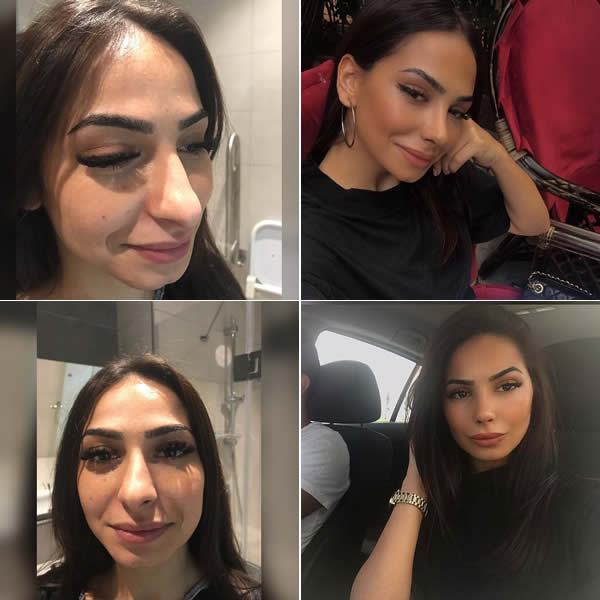
Ideal Candidate
Rhinoplasty surgery can be performed on men and women. For younger patients, it is recommended that you wait until the nose is fully grown. This means age 13 or 14 for girls and 14 or 15 for boys. Patients who decided on rhinoplasty nose surgery should be healthy both medically and emotionally.
What is Involved in the Rhinoplasty Consultation?
Scheduling a nose job surgery consultation is the first step in the process. A rhinoplasty consultation is designed to fully educate you about nose job surgery in a comfortable environment.
The consultation will include a discussion of your goals and an evaluation of your individual case. A physical examination of your nose will be performed. There will also be a discussion of the likely outcome of your surgery, the risk and complications associated with a rhinoplasty surgery, and the course of surgical treatment.
The success and safety of your surgery require that you fully disclose your health history, current medications, the use of vitamins, herbal supplements, alcohol, tobacco, and drugs.

What is the Revision Rhinoplasty?
Revision rhinoplasty refers to a surgical procedure performed on the nose after an initial rhinoplasty (nose surgery) has been done. The purpose of this secondary surgery is typically to correct issues or complications that arose from the first procedure or to make additional aesthetic or functional changes to the nose.
The surgery can be significantly more complex than primary rhinoplasty because the surgeon has to work with already altered tissues that may be scarred, making the anatomy more challenging to navigate.
What Anatomically is Involved in Rhinoplasty?
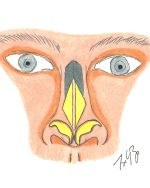
- The upper third of the nose is bone, and the lower two-thirds is cartilage.
- Cartilage portion of the nose (upper lateral, lower lateral, and septum)
- The bone, upper lateral, and septum make up the bridge of the nose.
- The lower lateral cartilage makes up the tip of the nose.
What Can Be Corrected in Rhinoplasty Nose Surgery?
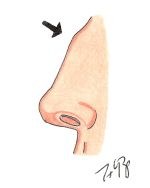
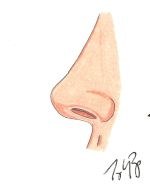
(In Rhinoplasty surgery, the bridge can be shaved down)
(In Nose Job surgery, the bridge of the nose can be narrowed)
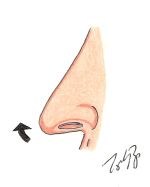

(The length of the nose can be shortened)
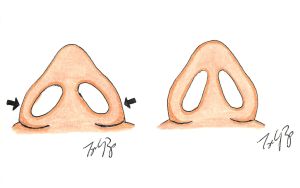
(The base of the nose can be narrowed)
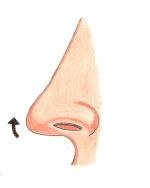
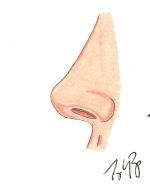
(The tip of the nose can be rotated upwards)
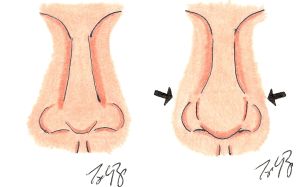
(The tip can be refined)

Where is the Rhinoplasty Performed?
A rhinoplasty surgery may be performed in your plastic surgeon’s accredited office-based surgical facility, an ambulatory surgical facility, or a hospital, possibly with an overnight stay.
It is more commonly performed under general anesthesia, although local anesthesia with sedation may be also used. These decisions will be based on the requirements of your specific surgery and considerations of patient and surgeon preference.
What is the Recovery After Rhinoplasty Surgery?
Recovery Process
The recovery process following rhinoplasty can vary from person to person. Here are some important points to keep in mind:
- Postoperative Care: Your surgeon will provide instructions on how to care for the surgical site, including keeping the nose clean, applying ointments or dressings, and taking prescribed medications.
- Bruising and Swelling: It is common to experience bruising and swelling around the nose and eyes following rhinoplasty. These effects will gradually subside within a few weeks.
- Physical Limitations: Engaging in strenuous activities, heavy lifting, or exercise should be avoided during the initial weeks of recovery to prevent complications and ensure proper healing.
- Follow-up Appointments: Attend all follow-up appointments with your surgeon to monitor your progress, discuss any concerns, and remove any sutures or dressings.
Although everyone heals at a different rate and the complexity of the rhinoplasty nose surgery is individualized, you can expect to recover will this general timeline.

When will I see the Results After Rhinoplasty?
The results of rhinoplasty surgery are visible almost immediately after surgery. However, it does take a full year before your final result. Numbness and firmness over the skin surface will resolve over the following months. It may also take a year or more for incision lines to fade. The final results of rhinoplasty are permanent. However, time and gravity can minimally change the soft tissue overlying your nose.
Can a Rhinoplasty be Performed with Other Procedures?
It is possible to have a nose job done with other procedures. Nose Job is commonly performed with other facial procedures like chin implants and facelifts. Rhinoplasty can also be combined with body procedures like breast augmentation.
The advantage of combining the procedures is that it allows for one recovery time, thus, missing less time off work or time away from your family.
What should a Rhinoplasty Patient Know before a Rhinoplasty Surgery?
- Know what exactly needs to be improved: it is very important the exploration performed by the plastic surgeon before the intervention because you have to detect the part of the nose that is altered, so for example the tip may be wide, narrow, or fall, or also that the bark is sunken or very protruding, which is usually the most frequent, and in some cases, it may deviate, due to trauma or birth. All of this will have to be taken into account to know what needs to be corrected, what is most worrying to the patient, and, finally, what can be corrected.
- The problem can be the chin: Another congenital deformity that occurs on the face is the nasal hypertrophy that is associated with the retroposition of the chin or short chin, in these cases you have to perform a profile that consists in addition to correcting the nose, increase the chin, obtaining an excellent result.
- It is not about having someone else’s nose: “sometimes young people bring us photographs of actors or actresses with a pretty nose, but it is important to explain that each nose goes with a type of facial features and some would be better off a type nose than others, ”says Dr. Emre Gonenc Baygol. Rhinoplasty intervention consists in correcting all nasal structures and giving the nose a harmonious shape with the rest of the face, it is not just about leaving it perfectly in shape, but it must be proportionate to the measurements of the face.
- Do not forget the functionality of the nose: in addition to its aesthetic importance on the face, this part of our body has great functional importance in the breathing process, explains Dr. Emre Gonenc Baygol, since the nasal mucosa is adequate to introduce air into the lungs. For this reason, a good specialist will treat the case when studying the nose not only from the aesthetic point of view but also from the functional point of view and if the respiratory function is diminished or altered, make a correction in the same intervention, to improve so the breath of it.
- Each time they are faster operations and the recovery period is shorter: it is important to know that the intervention is performed under general anesthesia, and usually, one day must be admitted to the clinic. During the postoperative period, the patient will be one week with a plaster, protecting the nasal bones, and with plugs that will be removed at 48 hours. Although the intervention is not painful, the periocular area is likely to swell slightly. But this swelling will disappear and it will not be until after a month when the patient begins to see the result, and definitely after a few months.
Always put yourself in the hands of professionals, as any other operation should always be performed by a professional surgeon, and when submitting to it, you must know what certifications guarantee the professionalism of the specialist.
One of the most important is belonging to medical societies such as the European Rhinoplasty Society. It is important to demand that the surgeon who is going to intervene know all the advances in rhinoplasty techniques, since today more open techniques are performed than closed ones, which also achieve more precision and perfect results.
Does Rhinoplasty Surgery Change the Voice of Patient?
In general, rhinoplasty surgery does not change the voice of the patient. Nose Job is a surgical procedure that is designed to improve the appearance and / or function of the nose, and it does not involve altering the vocal cords or any other structures that are involved in producing the voice.
However, there have been rare cases where some patients have reported changes in their voice after surgery. This may occur if the surgeon inadvertently damages or alters the nasal structures that are involved in sound production, such as the nasal passages, the soft palate, or the pharynx. These changes are usually temporary and resolve on their own within a few weeks or months.
It is important to discuss any concerns about potential changes in your voice with your surgeon before undergoing rhinoplasty surgery. A skilled and experienced surgeon can minimize the risk of complications and help you achieve the best possible results while preserving the function of your nose and other structures.
Potential Risks and Complications
- Rupture of small superficial vessels of the nose
- Infection
- Poor wound healing
- Anesthesia complications
- Hemorrhage (hematoma)
- Asymmetry of the nose
- In Longer-term surgical interventions, cardiac and pulmonary complications may arise, which may be due to the formation, or increase, of blood clots in the venous system
- Changes in skin sensitivity (numbness)
- During a rhinoplasty or septoplasty, there may be changes in the nasal airways that can interfere with the normal passage of air through the nose
- A Perforation in the nasal septum may form, but it is very rare additional surgery may be necessary to repair the nasal septum but in some cases, it may be impossible to correct this complication
- Pain, which may persist
- Unfavorable scarring
- Irregularities in the contours of the skin
- Discoloration and swelling of the skin
- The Sutures may emerge spontaneously through the skin, become visible or cause irritation that requires removal
- Possibility of revision surgery.
Important facts about the safety and risks of nose surgery The decision to undergo nose surgery is very personal and you must decide if the benefits will meet your goals and if the risks and potential complications are acceptable.
How Long is Nose Job Recovery?
The recovery varies a lot between each patient, however, in general terms, the first week is the most uncomfortable because the nose is blocked a little and it is when there is more inflammation, therefore the activities you carry out will be especially those with which you feel comfortable, yes you can go to work or to the movies or to dinner or etc. from day 2-3, but it depends on how you feel.
Most of the swelling and discomfort disappear around the 5th day so you feel more confident going out and going to work.
You should avoid efforts and exercise for 4-6 weeks but honestly, the recovery is very noble and with some minor discomfort. You will use a bandage on the nose only for 10-14 days and later you will only use a bandage to sleep.
Your nose will finish healing like any other tissue in your body that takes between 8-12 months but all scars are internal so there are no marks on the skin and nobody will notice that you are operated on except for the improvement in your image.
This helps the patient to have less inflammation and post-surgical bruising, leading to a faster and more ambulatory recovery, where the patient does not require a nasal plugging.
What is Rhinoplasty with Tension Threads?
It is a treatment that does not serve to fix all the problems that can be in a nose, but it does treat one of the most frequent: the fallen tip. The intervention is carried out under local anesthesia and is minimally invasive since only a small incision is made in the lower part of the tip of the nose. Next, the surgical thread is passed through that incision to pull the tip of the nose up and, at the same time, thin it.
The thread is the same as that used in other interventions, therefore it is a totally safe material that the body absorbs without any problem. The intervention can take from ten minutes to two hours, depending on the number of threads to be put on and the work to be done on the nose. Once it is finished, the patient can go home, since when only local anesthesia is applied, there is no need to monitor how the body reacts to it.
How Much is a Nose Job in Turkey?
The starting cost of rhinoplasty in Turkey is $2400 on average. In the price for rhinoplasty, there is a hospital charge, hotel charge, transportation, medical services from surgery preparations up to afterwards treatments, and also consultations and follow-ups.
Please click to get price from Estheticland
Frequently Asked Questions Related to Nose Job
The duration of the surgery can vary depending on the complexity of the procedure but generally takes between one to three hours.
Discomfort and mild pain are common after the procedure, but these can be managed with pain medications prescribed by your surgeon.
It is advised to take at least one to two weeks off from work or school and avoid strenuous activities for several weeks following surgery. Your surgeon will provide specific guidelines based on your individual case.
Functional rhinoplasty can enhance breathing by addressing structural issues. However, it is crucial to choose an experienced surgeon who understands the importance of maintaining or improving nasal function while enhancing aesthetics.
While there will be visible improvements immediately after the surgery, it can take several months for the nose to fully settle, and for the final results to be evident.
Yes, Turkey is a safe country for cosmetic surgeries such as nose jobs (rhinoplasty). Many people choose Turkey for medical tourism.
